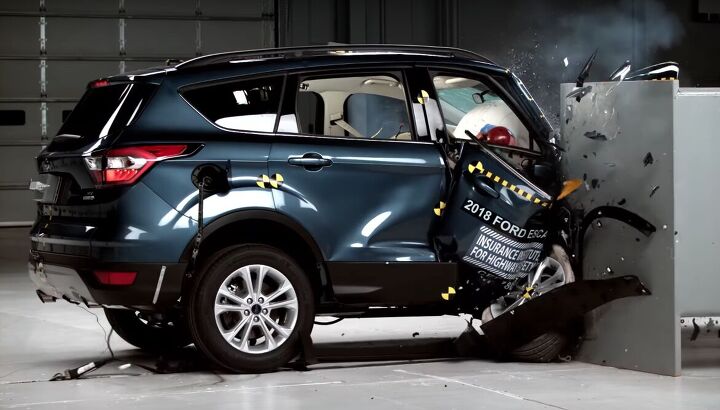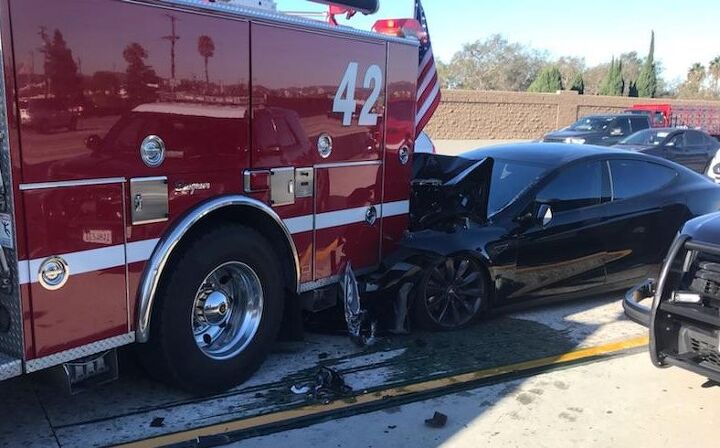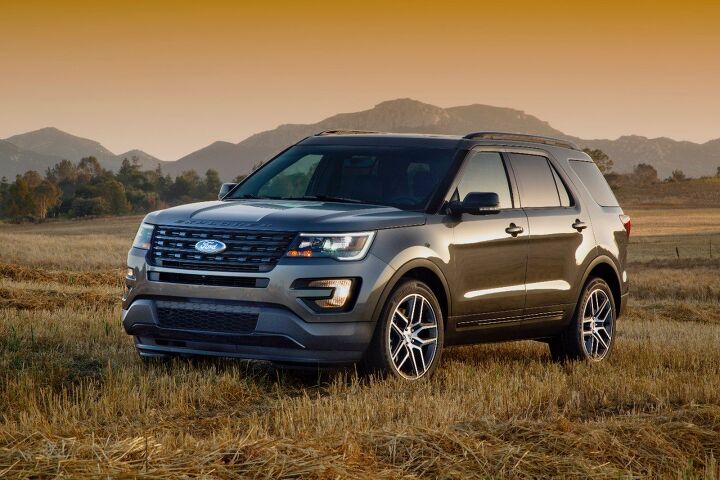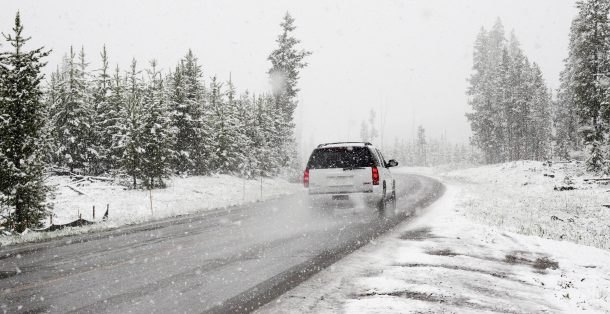#AutomotiveSafety
Deadly Design: SUV Proliferation a Contributing Factor in Pedestrian Deaths, Study Says
Sport-utility vehicles and crossovers are great for families who want maximized interior volume and a sense of security, but the high-riding vehicles are a double-edged sword. In addition to being less economical than a sedan with a similar footprint, the design doesn’t bode well for pedestrians. In fact, the proliferation of SUVs may be the largest contributing factor to pedestrian fatalities right now. From 2009 to 2016, fatal single-vehicle crashes involving utility vehicles increased by 81 percent.
That’s disconcerting, considering the number of pedestrian killed on U.S. roads declined by 20 percent since 1975, hitting an all-time low in 2009. However, in 2016 the death toll had climbed back up to the highest levels since 1990. The Governors Highway Safety Association estimated nearly 6,000 people were fatally struck by vehicles last year, with around 4,700 of those deaths occurring in urban or suburban areas. Conversely, those same environments only saw 2,959 deaths in 2009.
The increase in fatalities cannot be contributed entirely to the design of SUVs. Distracted driving, encouraged by smart phones and increasingly complicated infotainment systems, has undoubtedly pressed the issue. But, when a strike does occur, the shape of a vehicle still plays an enormous factor.
Tesla and NTSB Squabble Over Crash; America Tries to Figure Out How to Market 'Mobility' Responsibly
The National Transportation Safety Board, which is currently investigating last month’s fatal crash involving Tesla’s Autopilot system, has removed the electric automaker from the case after it improperly disclosed details of the investigation.
Since nothing can ever be simple, Tesla Motors claims it left the investigation voluntarily. It also accused the NTSB of violating its own rules and placing an emphasis on getting headlines, rather than promoting safety and allowing the brand to provide information to the public. Tesla said it plans to make an official complaint to Congress on the matter.
The fallout came after the automaker disclosed what the NTSB considered to be investigative information before it was vetted and confirmed by the investigative team. On March 30th, Tesla issued a release stating the driver had received several visual and one audible hands-on warning before the accident. It also outlined items it believed attributed to the brutality of the crash and appeared to attribute blame to the vehicle’s operator. The NTSB claims any release of incomplete information runs the risk of promoting speculation and incorrect assumptions about the probable cause of a crash, doing a “disservice to the investigative process and the traveling public.”
Driving Aids Allow Motorists to Tune Out, NTSB Wants Automakers to Fix It
Driving aids are touted as next-level safety tech, but they’re also a bit of a double-edged sword. While accident avoidance technology can apply the brakes before you’ve even thought of it, mitigate your following distance, and keep your car in the appropriate lane, it also lulls you into a false sense of security.
Numerous members of the our staff have experienced this first hand, including yours truly. The incident usually plays out a few minutes after testing adaptive cruise control or lane assist. Things are progressing smoothly, then someone moves into your lane and the car goes into crisis mode — causing you to ruin your undergarments. You don’t even have to be caught off guard for it to be a jarring experience, and it’s not difficult to imagine an inexperienced, inattentive, or easily panicked driver making the situation much worse.
Lane keeping also has its foibles. Confusing road markings or snowy road conditions can really throw it for a loop. But the problem is its entire existence serves to allow motorists to take a more passive role while driving. So what happens when it fails to function properly? In ideal circumstances, you endure a moderate scare before taking more direct command of your vehicle. But, in a worst case scenario, you just went off road or collided with an object at highway speeds.
The NHTSA Might Finally Get That Lead Administrator It's Been Missing
It’s been over a year since the National Highway Traffic Safety Administration had someone officially running the show. While plenty of political appointments have been held up by Senate approval, the NHTSA is one President Trump has neglected since taking office. Former General Electric executive Heidi King has been the Deputy Administrator since September, and will be the one Trump taps to assume overall leadership of the agency. It’s about time.
The NHTSA has to cope with the planned fuel efficiency changes, oversee the neverending Takata airbag recalls, and start doing some damage control with autonomous vehicle development. While the recall issues are likely to remain business as usual, the current administration has pursued lax standards for both autonomous safety and corporate efficiency rules — and both have seen growing opposition.
Entire states are already pushing back against the proposed fuel efficiency rollbacks and there have been two fatalities involving self-driving and semi-autonomous technology within the last month. Because of this, promoting King might be a wise choice. Her corporate ties have some people concerned she’ll go easy on businesses, but at least she already has some experience in dealing with the big issues.
Latest IIHS Crash Tests: Throwing Small Crossovers at the Wall, Seeing What Sticks
The Insurance Institute for Highway Safety (IIHS) has released new ratings for seven small utility vehicles. For the most part, the pint-sized crossovers performed amicably. However, none of the models were worthy of the group’s coveted “Top Safety Pick Plus” award due to subpar headlamp performance, while a couple of models were found structurally deficient after being confronted with the dreaded small overlap crash test.
Ford’s Escape received an overall poor rating and came away from the test with the worst structural deformation within the group. Senior IIHS research engineer Becky Muller noted that Ford reinforced the diver’s side of the vehicle for the 2017 model year but negated extending that courtesy to passengers.
“Disparities like this one are why we decided to formally rate the passenger side in the small overlap test after five years of evaluating only the driver side,” she explained. “Manufacturers shouldn’t shortchange protection for front-seat passengers.”
Idiot BMW Driver Calls 911 to Tell Police He Can't Stop Speeding
Earlier this week, the driver of a 2003 BMW X5 called 911 to inform the operator that he was speeding and wouldn’t be able to stop. The motorist, one Joseph Cooper, explained to the operator “my gas pedal is stuck” as his SUV barreled down a Florida interstate at around 100 miles an hour. Officers were dispatched to the highly mobile scene on Monday at 1:00 p.m. and ultimately decided to halt Cooper’s progress using stop sticks.
BMW is calling bullshit on his runaway vehicle claims, and we’re inclined to agree. There were loads of things the driver could have done to stop the vehicle but, based on portions of his call with 911, he was either unwilling or incapable of performing those tasks.
Here's Trump's Ace in the Hole for Dialing Back MPG Rules
It’s no secret that the Trump administration will eventually come forward with a relaxed version of existing automotive fuel economy targets. Despite previously agreeing to them, most automakers have decided Obama-era goals are less than ideal and have reached out to the current president to take it easy on them — something he appears willing to do.
However, the White House is going to have to sell the decrease to numerous states that claim they won’t accept such a proposal, as well as a driving public that likely doesn’t want to spend more money on fuel than it has to. Fortunately, the administration has a strategy for this, and has tapped the National Highway Traffic Safety Administration for backup. It’s trying to prove that cutting fuel economy would actually make vehicles safer.
Drowsy Driving Might Be a Bigger Problem Than Previously Thought
Back in 2014, an American Automobile Association study estimated that tired motorists were responsible for around 328,000 accidents annually — 6,400 of which were fatal. However, unlike drunk driving, there’s no sound metric for assessing the true scope of the problem. Getting tired is something that just sort of happens. People don’t stay out all night not sleeping because it’s fun, the police can’t test for it, and almost nobody is going to say they were dozing off behind the wheel in an accident report — either because they are too embarrassed or stopped feeling tired at the moment of their brush with death.
That makes the issue a bit of a phantom menace. We all know it’s a problem, but the frequency remains debatable. Fortunately, a new study released by AAA this week helps clear things up. Researchers affixed dashboard cameras to 3,593 vehicles in order to monitor the drivers’ faces, then used a PERCLOS-based fatigue monitoring strategy to come to the conclusion that drowsiness is a contributing factor in 10.6 to 10.8 percent of all accidents resulting in significant property damage, airbag deployment, or injury.
Toyota Recalling Late-model Prius and Specific Lexus SUVs
Toyota announced a recall of roughly 49,000 vehicles in the United States on Wednesday. Affected models include the 2016 Toyota Prius, the 2016 Lexus RX, and the 2015-2016 Lexus NX crossover. The safety issue involves the airbag systems that could fail due to an electrical problem.
Unlike the scary Takata recalls, the biggest danger here is the non-deployment of the front or side-curtain inflators. Toyota claims an open circuit could develop within the system’s sensor. If this were to occur, the airbag warning light should illuminate to indicate a failure.
Idiots Need to Understand That Self-driving Cars Aren't Here Yet
With automakers, the Department of Transportation, NHTSA, and Congress all attempting to get self-driving vehicles onto the road as quickly as possible, the autonomous revolution finds itself in a sticky situation. Some motorists are confusing their semi-autonomous technology with an impenetrable safety net. This has resulted in avoidable accidents as drivers assume their high-tech cars can cope with whatever’s thrown at them, and it’s probably going to get worse as more idiots buy them.
We’ve already covered how semi-autonomous features make everyone less-effective behind the wheel and the fatal Tesla Autopilot crash was a story we kept up with for over a year. Investigators ruled that accident was the perfect storm of mishaps, however, there remains a common thread between the two pieces. The driver may have been spared were he not so eager to put his faith into the vehicle’s semi-autonomous system.
On Monday, a Tesla Model S collided with stopped firetruck that was responding to an accident on a freeway in Culver City, California. As you already guessed, the driver told the firefighters that the vehicle was operating in Autopilot mode. While nobody was injured in the crash, it’s another stroke in the ugly portrait of people placing blind trust in a technology they don’t understand. And, boy oh boy, are we just getting started on illustrating this problem.
Safety Group Leans on Ford to Recall 1.3 Million Explorers
After receiving negative attention from various policing agencies over a potential carbon monoxide leak in Explorer-based Interceptor Utility vehicles, Ford is being urged by the Center for Auto Safety to recall over a million vehicles. While the automaker hasn’t yet done so, it hasn’t been sitting on its hands, either. The automaker issued technical service bulletins to service centers, dispatched its own investigative teams to examine police fleets, and said it would work with the National Highway Traffic Safety Administration as the agency conducted a probe of its own.
Ultimately, Ford said the vehicles were safe — attributing the claimed monoxide leaks to aftermarket modifications common on police vehicles. However, it also agreed to examine and repair any Explorer (for civilian or official use) in the hopes of reassuring worried owners. Meanwhile, customer complaints ballooned after news of the story broke.
In July of 2016, the NHTSA had fewer than 200 Explorer-related grievances on file. The Center for Auto Safety claims that number has now grown to 1,400.
400 Deaths Per Day: Is India Seeking Automotive Safety in the Wrong Places?
Every year, nearly 40,000 people lose their lives on American roadways. Tragic as that may be, it’s small potatoes when you consider India hovers around 150,000 annual fatalities. While you could attribute the difference to the 1.32 billion people living in the country, the truth is that car ownership in India is far less common than in the United States.
Here, there are about 255 million functioning vehicles, leaving the majority of the population with access to some form of four-wheeled transportation. However, in India, the number is closer to 55.7 million — which only gives 42 people out of every 1,000 access to an automobile.
Confronted with a situation that can only be described as catastrophic, Prime Minister Narendra Modi is seeking to impose harsher penalties for traffic violations and requiring automakers to add safety features to cars sold within the region. While that’s a fine start, it doesn’t address the core issue: a nationwide lack of discipline behind the wheel.
'Tis the Season: Holiday-related Driving Deaths By State
In addition to being needlessly stressful, obligatory holiday travel poses an elevated risk of roadway mishaps. Inclement weather, congested highways, and overtaxed drivers traversing long distances is an exceptionally bad formula. We don’t have to spell it out further; you’ve likely seen seasonal roadside tragedies firsthand and been thankful it wasn’t you.
However, depending on where you’re making your holiday pilgrimage this year, the associated risks could be much higher or lower than someone traveling a few states over. Not all regions are created equal, and some parts of the United States appear to be particularly susceptible to road fatalities during annual festivities.
The IIHS' Updated Criteria Absolutely Devastated Its Top Safety Pick List
While the Insurance Institute for Highway Safety has steadily upgraded its standards over the last two years, the effort hasn’t been without casualties. In a new effort to improve headlight safety and impact protection, the organization has changed its testing criteria for 2018 to include both illumination and passenger-side frontal impacts.
Unfortunately, including these aspects in its final verdict of how safe a vehicle is has removed numerous models from consideration for 2018’s Top Safety Pick+ awards. Last year, 38 vehicles qualified for the safety plus appointment. This year, however, the grand total only came to 15 models — most wearing badges from Hyundai Motor Group and Subaru.
The IIHS makes no apologies for keeping so many cars from receiving top honors. Instead, it claims it was time to heap higher expectations on automakers for items like visibility and passenger safety.
Automakers Need to Improve Voice Command Systems ASAP
Amazon’s Echo has already invaded homes across North America, but it’s now beginning to creep into vehicle infotainment systems. My parents have one and both are quite fond of its ability to answer basic queries through intuitive voice commands. Though my mother refers to the system as my father’s “new wife,” it prefers to be addressed as Alexa when being issued instructions. If you need another point of reference, it’s reminiscent of Apple’s Siri, the computer from Star Trek, and any other automated technology using a female voice as the primary interface.
However, as handy as these systems are, they sometimes make mistakes. Alexa is great at giving me the weather but, when you give her more complex requests, she’ll sometimes get confused. That’s not a big problem when you are able to whip out your phone and go online, but it can be real annoying when driving. Early voice command interfaces in automobiles were infuriating — it was often easier to give up and input whatever information you were trying to shout at Ford Sync, BMW iDrive, or whatever decade-old system you happened to be using.
Thankfully, voice recognition is far better now than it was in 2008. But with so many concerns about automotive safety cropping up, it’s a little surprising that nobody has yet perfected an interface that effectively allows motorists to keep their hands where they belong — on the wheel.






























Recent Comments